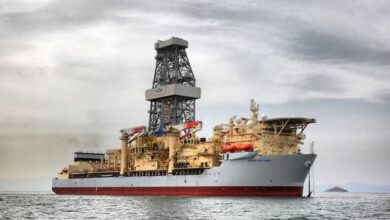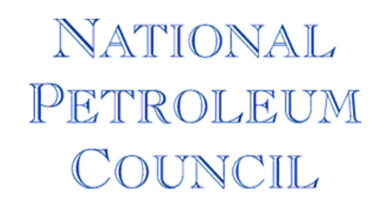BP readies Houston well capping package for global deployment
Operator undertakes significant logistics studies, exercises to boost containment capabilities
By Linda Hsieh, managing editor

Although BP has continued to stress prevention as the primary focal point of its well control initiatives since April 2010, the operator has not neglected work on its $50 million global deepwater well capping and tooling package. During a press tour on 9 May of the capping package, held at the Houston warehouse where the tools are maintained for 24/7 readiness, Felipe Bayon, SVP for BP America and head of global deepwater response, noted that the company hopes it will never have to deploy the capping stack. However, having it ready underlines BP’s commitment to “advance our own internal capabilities to ensure that something like Deepwater Horizon never happens again,” he said.
The 5 1/8-in. capping stack, which is rated for up to 15,000 psi, 10,000-ft water depths and 100,000 bbl/day flow rate, was delivered to BP’s containment response team in August 2011 after a development period of just eight months. It consists of two sections – the lower module is a horizontal subsea production tree with integrated pressure and temperature sensors, and the upper stack consists of a hydraulic connector and two gate valves. The subsea tree and gate valves – typically long-lead items – were sourced from other BP projects during 2011, enabling the fast-track delivery time. “If you start from scratch on the capping stack, you’re probably looking at two years,” Geir Karlsen, leader of BP’s containment response team, said.
He explained that the stack was designed as two separate sections in order to meet a fundamental design criteria – the system had to be air-transportable so it could be rapidly deployed. Altogether, the cap and tooling package weighs approximately 650 metric tons, requiring 60 lifts and 40 trailer loads. “It takes seven heavy-lift aircrafts to fly the package from Houston to a region where we operate,” Mr Karlsen said.
BP has selected the Antonov AN-124, a Russian-designed jet aircraft, to do the major lifting. “The lower capping stack weighs about 75 metric tons with the shipping frame, and there is no other aircraft that is commercially available that can handle that kind of load,” he continued. Multiple Boeing 747s also would be used to assist with the transport process in the case of an incident.
“It’s a huge package. It’s not just a capping stack. It’s everything around the capping stack, everything around the support equipment that you may need in a well control incident… The equipment is growing as we keep developing the system,” Mr Karlsen said.
Key parts of the 250-plus pieces of discrete equipment that make up the toolkit include a subsea dispersant package, a range of ROV tools with saws, torque tools and other debris removal tools, pipe grapples and pipe shears, and a subsea hydraulic power unit with a launch and recovery system that provides hydraulic power for the capping stack operations.
“We also have a kit called the subsea hydraulic accumulator system that is to provide emergency hydraulic power to the BOP stack,” Mr Karlsen said.
A range of cap adapters also has been built to fit the different risers used on BP rigs around the world. “The capping stack is designed to land on the top of the BOP stack after you remove the LMRP. That’s our primary landing point… But if for some reason you’re not able to remove the lower marine riser package, we have to land on top of what we call the flex joint riser adapter,” he explained. This is where the bottom riser joint hooks up to the LMRP.

“Those connection points on BOPs have different risers… In our fleet of rigs worldwide, we have 11 different risers. That means we have 11 different types of connections,” he continued. BP keeps two of each adapter type – a primary and a backup; they are run on winch wire using a special H4 connector running tool.
Besides the top of the BOP and the top of the LMRP, the last landing point option is on top of the wellhead, after removing the BOP. “Those are the three options that we are set up to service, but the primary landing point is the top of the BOP stack because that’s where you have the best pressure integrity,” Mr Karlsen said.
In the event that BP can’t cap a flowing well, the package also includes an ROV-operable flowback assembly that would be installed via a hub on the upper capping stack. “Let’s say well integrity will not allow you to shut in because either you could fail a casing, or you could broach the lower shoe and flow will come back outside the casing. Our flowback system gives the capability to flow back to a seabed infrastructure,” Mr Karlsen explained. This would involve installing flexible flow lines and a free-standing riser system to collect flow to the surface.
 “These all make up a response package that you may need for a well control incident,” Mr Karlsen continued. “It’s probably more than you need, in some cases, but you may have to source additional equipment. It’s all really well-specific.”
“These all make up a response package that you may need for a well control incident,” Mr Karlsen continued. “It’s probably more than you need, in some cases, but you may have to source additional equipment. It’s all really well-specific.”
Logistics planning
“Operating this system is not just having the hardware sitting in a warehouse and thinking you’re OK. You are not OK because it takes a lot to maintain it and plan logistics and plan the use, and making sure the regions are ready for the system,” Mr Karlsen emphasized during the tour.
BP continues to enhance its planning around the cap package and make sure both the response team and the operating regions understand all the details that would be involved in moving the package from Houston to a country of need. “Customs clearance is a huge issue because you do not want to get hung up in customs here in Houston or in a receiving country because there is something missing,” he said.
Numerous logistics surveys have been conducted to understand not only customs requirements but also the capabilities and infrastructure in each country. “That is looking at airports: Are they capable of receiving an Antonov AN-124? Are they capable of receiving a 747? Can they offload the 747? The 747 has special offloading equipment… If you don’t understand airports on the other end, you may end up loading equipment that you cannot offload on the other end,” Mr Karlsen said. The logistics surveys also include studies of roads and bridges, transport permit issues, and availability of trucks, trailers and mobile cranes, etc.

Every region also must create its own containment response plan. “Part of that response plan is looking at vessels in the region and identify vessels that you need available to you to be able to deploy the capping stack. The primary method is to run the capping stack on wire, so you need a subsea crane with big enough capacity to lower the lower capping stack, which is the heaviest piece,” Mr Karlsen explained.
The BP containment response team in Houston also continues to carry out tabletop exercises with the various operating regions to ensure understanding around how the system is used and how to transport it. So far, tabletops have been conducted with BP teams in Egypt, Azerbaijan, the UK, Norway and Brazil, and exercises with other regions, including Australia and Angola, are coming up.
The Houston team itself also did an exercise in January where it loaded most of the key components onto trucks and put together all paperwork, including customs clearance documents. “We learned a lot on efficiency in making sure that if we ever get the call-out, we are ready to go,” Mr Karlsen said. “We are waiting for an opportunity for an Antonov AN-124 to come to Houston… We’ll mobilize from here, put the equipment on the truck, haul it to the airport, load the Antonov- AN-124 and tie down the equipment and be ready to fly… We think we have pretty good plans, but you always learn something when you do an exercise like that.”

Although BP has publicly stated that it believes it can cap a well in 35 days, Mr Karlsen stressed that the time table for any incident will be specific to the well and blowout conditions. “What your debris field looks like, what condition is the BOP in? There are a lot of factors that play into that… We are pretty comfortable we can move the package to a region in about 10 days, but that again depends on aircraft availability,” he said.
Because there are only 17 Antonov AN-124s available worldwide, BP is working closely with Panalpina, a Switzerland-based company that provides freight forwarding and logistics support services, and Volga-Dnepr, the Ukrainian company that owns the largest fleet of Antonov’s in the world, to create detailed logistics plans. If there is an incident, BP would work with those companies to source the necessary aircraft. “We’ll do everything we can do get access to the aircraft as soon as possible,” Mr Karlsen said.
He stressed too that the 747s will get to the receiving country much faster, carrying priority equipment that is needed for an initial response. These would include ROVs and sonar packs to begin the surveying process. “You don’t need everything there on day 1, certainly not the cap on day 1. First thing is to figure out what’s going on… It’s getting the survey done, understanding what your next move is. Every step of the way you’ll learn something that will affect the next decision we make,” Bill Grames with the BP Global Deepwater Response group said.

To keep the cap package at 24/7 readiness, BP has set up a quarterly maintenance program that includes using ROV tools to function valves and inspecting or changing out the hydraulic fluids. “On the 12-month service, we actually do a full pressure test of the system up to 15,000 psi,” Mr Karlsen said. He added that BP will look at an appropriate recertification period for the system, perhaps every five years.
Such recertification might take the system out of commission for a period of time, but BP would have access to other capping stacks during those periods. These would include the Marine Well Containment Company stacks in the US Gulf of Mexico, the OSPRAG stack for the UK North Sea and an in-country stack BP has in Angola.

Further, the operator has access to the four capping stacks being managed by Oil Spill Response Ltd. One 7 1/16-in., 10,000-psi stack will be located each in South Africa and Singapore; one 18 ¾-in., 15,000-psi stack will also each be placed in Norway and Brazil. The first one was delivered to Stavanger in March, the second was delivered to Singapore in June, and the other two are expected to be completed this year.
Other companies and groups are also developing their own capping stacks around the world, said Mr Karlsen, who believes there will be 16-18 caps of various types in the industry worldwide by the end of the year. “It’s a new industry that’s grown around capping and containment,” he said.
Click here to read more about the 2nd OSRL capping system delivered to Singapore.





